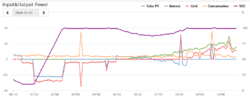I agree with
@flameport I get a graph showing what power I have used, One can see the spikes when I made coffee ... and having viewed the data over months, the only time we tend to exceed the supply from solar panels and battery is when having a shower.
Very much so. I think many people seriously under-estimate the effects of 'diversity' (over time)and hence the maximum demand on a circuit or whole installation.
I reproduce below a message I posted about 5 years ago
(click here) . Even though in,my very large house, I have a washing machine, dishwasher, tumble dryer, immersion heaters, fan heaters and all the other usual domestic loads (including a good few 'workshop tools0, over an approx 2.5 year period, the total demand of my installation only exceeded 30A on 1,489 out of about 1.35 million minutes (about 0.1%), and exceed 40A for only 6 of those 1.35 million minutes (about 0.0004%).
Those figures are for my entire installation, so those for individual circuits within it will generally be a lot lower.
--------------------- reproduced message -------------------------
In another thread
(click here) , there has been extensive discussion about the estimated ‘maximum demand’ of a domestic electrical installation and the associated concepts of diversity. It has been pointed out in that discussion that real-world ‘maximum demands’ are usually surprisingly low.
To illustrate this, I present here some data relating to the last ~2.5 years (about 1.35 million minutes) of my electrical installation. Although data is captured roughly 5 times per minutes, I have it recorded as averages over each 1-minute period, and it is those 1-minute averages which are presented here.
It has to be said that it is a very atypical domestic property. Although now usually only occupied by two people, it is very large, with a 3 x 80A electricity supply and about 30 final circuits. There are no large electrical cooking appliances (only microwave, fat fryer, bread maker, toaster etc.) and the two electric showers are virtually never used. There is, however, a silly number of refrigeration devices! Something like one third of the total electrical consumption results from nocturnal hot water heating.
The first graph below shows the distribution of the instantaneous (1 minute) total demand, indicating that for the vast majority of periods the total demand is under about 5A. The small peak around 15-16A relates to periods when the 3kW immersion is the main load.
The second graph shows the same data, but in terms of cumulative figures, indicating that some 80% of all minutes have a demand below about 4A, about 92% of all minutes have a demand below about 14A and about 98% of all minutes have a demand below about 20A.
The final three graphs are ‘inverted’ versions of the second, the final two being ‘magnified versions’ which show what happens at the extreme tail (moments of highest demand). These show that only about 1% of minutes have a total demand >24A, and only about 0.01% of minutes (about 1 minute every week) have a demand >32A.
Over all the ~1.35 million minutes observed, the mean total demand was 4.35A and the median 2.97A. The lowest demand was 0.35A and the highest 40.36A. Summarising the number/percentage of minutes with total demands above a certain figure. As can be seen, under 2% of minutes had total demands >20A, and almost none had total demands above 30A. For about half of all minutes, total demand was under 3A.
Yes, I know that the appendix of BS 7671 talks about dedicated circuits with fixed appliances over 2 kW, but in real terms the only appliance between 2 and 3 kW which draws high current for a long time is the tumble drier and immersion heater, ...
Indeed - and, in common sense terms, that should only apply to fixed appliances which consume over 2 kW continuously for long periods, which is not the case for things like washing machines and dishwashers or (depending on appliance and usage) not necessarily even true of thjngs like tumble dryers. In my case, even my immersion hetaer rarely draws 3kW continuously for more than about 30 mins.
and since heat pump tumble driers arrived, now only the immersion heater really needs a dedicated supply.


